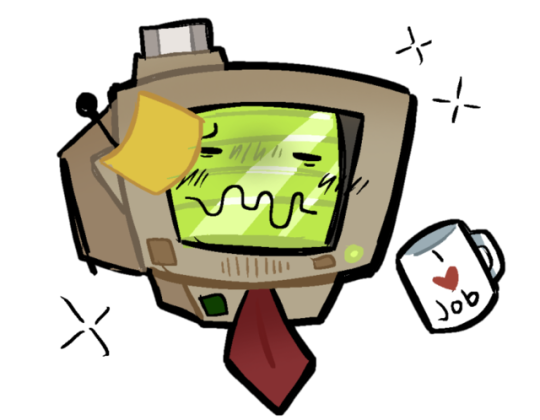#VR Games
Explore tagged Tumblr posts
Photo
Art vs. Reality
youtube

443 notes
·
View notes
Text
DO WE REMEMBER HIM?? </3

#artists on tumblr#artwork#art#robot art#robot#robots#robot kisser#robot fucker#job bot#job simulator#vr games#vr#virtual reality#gaming
81 notes
·
View notes
Text









Details of pictures I've taken 👁️👁️ pt. 15
Like/reblog/comment if you save ⭐
#wallpapers#background#homescreen#wallpaper#lockscreen#fondos de bloqueo#fondos de pantalla#fondos de celular#iphone lockscreens#iphone wallpaper#iphone lockscreen#phonewallpaper#phone background#phone wallpaper#skycolors#lilac sky#sunset#sunrise#old building#liminal#sky#clouds#boxing#cake#birthday cake#vr games#city lights#city photography#cityscape#city aesthetic
88 notes
·
View notes
Text
where braincells? are they lost?
103 notes
·
View notes
Text
JobBot gijinka,,dfd

#job simulator#vacation simulator#robot#robots#object head#vr games#monitor head#computer#tv head#sorens art
57 notes
·
View notes
Text
Jax didn't change. At all. He is still the same arsehole from the first time we saw him.
From what I remember; he was dismissive of Ragatha, manipulated an emotionally vulnerable Kinger, pushed Gangle to her potential death and didn't give two fucks that Kaufmo died of dismay. All in episode 1
What changed, is that the audience saw what happens we Jax doesn't get his way.

Jax doesn't just seem "disappointed" here. He seems seething, like a child, and we get a good wide close up of his face just to make it's clear he's absolutely not happy in any way.
Episode 2 seems to be setting up how different people react to being in a seemingly inescapable scenario, a la time loop nihilism.

You have Pomni and Ragatha who try to reach out to others, trying to build a supportive collective. There's Kinger and Gangle, who are stuck in survival mode and need that support assistance. Not everyone is in the mental position to help out as they want to be. With enough time and reassurance, Gangle may be able to break out of her insecurities. Kinger... I'm saying this as someone who relates to Kinger the most out of the cast: I think my king is stuck with his chronic anxiety and neurodivergencies. Someone give him a Lexam and Intuitive. So with Jax...
Jax is playing a video game. To him, this is just Undertale with multiplayer and he wants to see what happens on the genocide route. He's so under stimulated for meaning that he wants to fuck around and find out. If you want to find out what happens in a boring co-op game, what's funnier? Jumping into the enemy pit yourself, or getting your buddy to jump in instead. He may not even see the main cast as other players. What separates Gumigoo from Ragatha? The princess? The goop monsters? ... Kaufmo? Jax just might have lost his sense of humanity in everything but himself. Cogito ergo sum. I think Jax is meant to be a criticism of people who unironically think everyone is varying degrees of those NPC roleplay videos.
So yeah, I never saw Jax as Bugs Bunny. He was always a toxic League of Legends player stuck in VR coop game to me. We're just thankfully spared of his gamer words. Maybe when we see more of Zooble, we'll see someone stand up to him. No promises.
#the amazing digital circus#tadc jax#jax digital circus#disc horse#tadc#video game#youtube#media#coop#co op games#toxic gamer#gooseworx#glitch productions#glitch#tadc zooble#tadc kaufmo#tadc kinger#tadc gangle#tadc gumigoo#vr games#npc#npc roleplay#npc rp
289 notes
·
View notes
Text
We ask your questions so you don’t have to! Submit your questions to have them posted anonymously as polls.
#polls#incognito polls#anonymous#tumblr polls#tumblr users#questions#polls about interests#submitted nov 27#vr#vr games#virtual reality#vr headset
294 notes
·
View notes
Text
I would love a vr security breach map with friemdly animatronics to play in 🥺






#age regressor#sfw age regression#sfw little blog#age regression#sfw blog#age regression stuff#sfw agere#safe agere#sfw age regressor#age regression blog#security breach#fnaf security breach#fnaf glamrock#fnaf vr#vr games#sun and moon fnaf#pictures from google
73 notes
·
View notes
Text


New Phoenix drawing
:D
62 notes
·
View notes
Text
Not what I usually post but I’m desperate ok
Murder Drones fans who are 18 and older, do you happen to have vrchat 👀 I’d really like to have more VRChat friends and I’m too scared to go into public instances 💔
Please shoot me a dm or something saying you wanna be VRChat friends and like murder drones and are autistic PLEA

#artists on tumblr#small artist#murder drones#vrchat#vr games#looking for moots#moots#vr#virtual reality#i want more friends#digital art#doodle#serial designation n#md n#murder drones fanart#PLEASE I NEED MORE VRCHAT FRIENDS#IM DESPERATE#berriirambles
48 notes
·
View notes
Text
ITS FINISHED! The Haven’t you noticed I’m a star IEYTD MAP is done!
I’ve absolutely loved working on this with my team and I hope you enjoy it too!
youtube
#ieytd fandom#ieytd fanart#i expect you to die#agent phoenix#agent phoenix ieytd#original art#multi animator project#art#youtube#vr games
34 notes
·
View notes
Text

We view and we don’t judge… this is from before I even attempted to draw comics in a clear layout and before gutters, however it’s one of my favourites. I promise my art has improved!
#my art#original art#art#fanart#comic#ieytd#i expect you to die#EOD#enhanced operative’s devision#secret agent#agent phoenix#escape#escape room#vr#vr games#virtual reality#drawing#traditional drawing#traditional illustration#traditional art#alcohol pens
26 notes
·
View notes
Text
Functional VR Headset for The Sims 2

You can buy this object from Buy Mode in Electronics-Entertainment for 2500 simoleon. Children can use it too. There are 2 options:
Play with VR: Your sim wears the headset and starts some animations (like shown in the video below). Fun increases while Energy decreases. When you stop the action, the headset returns to the base.
Work Out with VR: Your sim wears the headset and starts some workout animations (see the video below). Sim will gain Body Skill. Fun increases while Energy and Comfort Decrease. When you stop the action, the headset returns to the base.
DOWNLOAD HERE
#the sims 2#ts2#sims 2 cc#sims 2 download#the sims 2 cc#ts2 download#4to2#4to2 conversion#buy mode#functional#electronics#vr goggles#vr games#workout
288 notes
·
View notes
Text










The Midnight Walk
Reveal Trailer
Website / Steam
56 notes
·
View notes
Text

TempBot!!! Yyah
49 notes
·
View notes